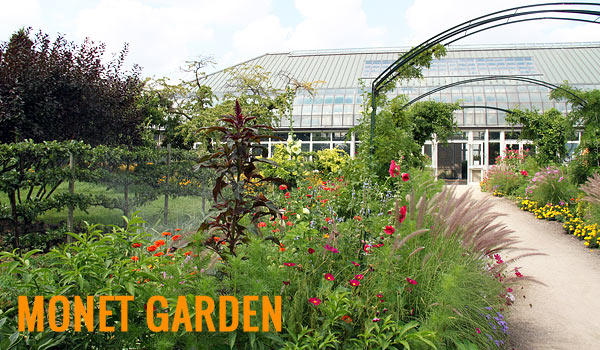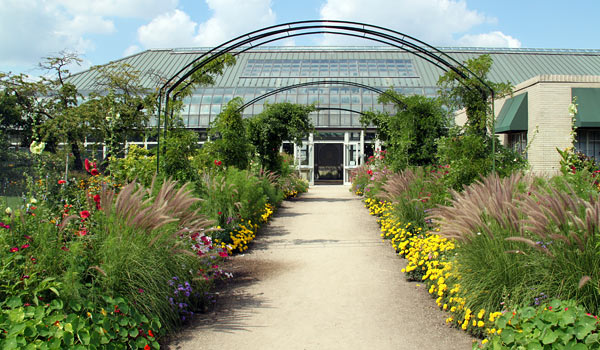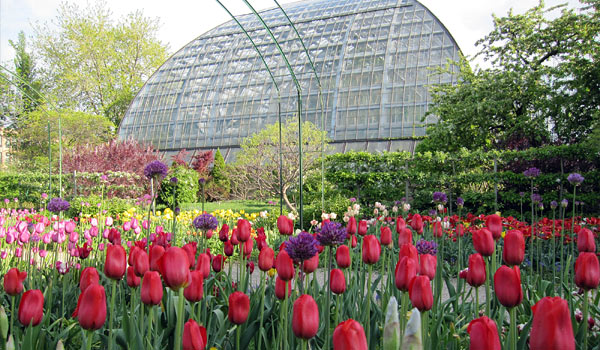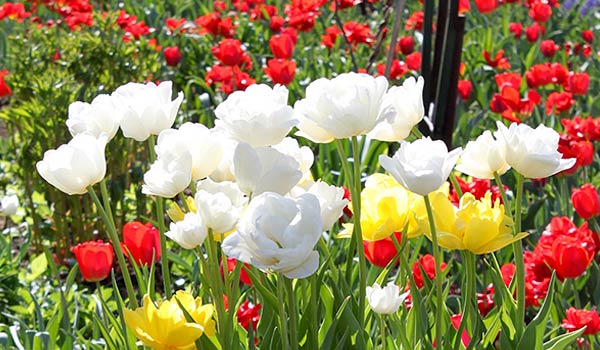Monet Garden
The Monet Garden is an adaptation of impressionist painter Claude Monet’s well known garden at Giverney, France. Originally created as an indoor display for the 2000 Flower and Garden Show at Navy Pier, the award-winning garden was subsequently transplanted to the conservatory grounds at the close of the show.
The garden is a very miniature and very loose interpretation of Monet's actual garden designed by former Conservatory General Foreman Bryce Bandstra. It features many of the same types of plants; and it plays with color in much the same way that Monet did. Like his garden, the main allee down the center is filled with bulbs in the spring which then switch to iris, peonies and poppies, and then nasturtiums, sunflowers, and a range of other annuals and perennials for the remainder of the season. Some of the beds are themed with blue or white or pink flowers. Smaller "paint box" beds play colors against each other like Monet liked to do. He used these to explore the qualities and combinations of colors.
Some of the most popular features in the garden are the espaliered fruit trees, the wisteria standards, and the picnic area on the stone terrace. The newest addition to the Monet Garden is a Living Wall constructed on the north end of the garden. Built with a generous donation of materials from Tournesol Siteworks, the Living Wall contains over 300 flowers growing on a vertical surface to create a stunning work of living art. Our Living Wall demonstrates a garden option for city-dwellers who don’t have yards. Another benefit of living walls is their ability to regulate temperatures in the room on the other side of the wall, helping to lower energy costs.
Hours
The Monet Garden is open during Conservatory Hours 9:00 am – 5:00 pm daily; Wednesdays till 8:00 pm
History
The Conservatory's Monet Garden is a homage to the 1890’s Gardens of Giverny. Built in the year 2000 and inspired by the gardens at Giverny, France (the home of the famous painter, CIaude Monet), the Monet Garden is a relatively new display for the Conservatory. It was first designed and built for participation in the 2000 Flower and Garden Show at Navy Pier here in Chicago. The display was so well received that the Park District decided to move their impressive garden to the Conservatory for permanent display and caretaking.
When Monet and his family settled at Giverny, France, in 1883, he immediately began re-visioning the grounds to suit his artistry and taste. Monet did not like organized or constrained gardens. He combined flowers according to their colors and allowed them to grow quite freely, placing the most common of daisies alongside rather rare varieties of plants. Monet was also known for his "paintbox" flower beds, where he experimented with different color combinations. In spring, summer and fall, the Conservatory's Monet Garden, like its namesake, displays a variety of sunflowers, nasturtiums, poppies, peonies, irises, and other colorful blooms in the "paintbox" fashion, and the central alley is covered by iron arches on which climbing plants can grow. Monet said, "I perhaps owe having become a painter to flowers." In the tradition of Claude Monet, who made his gardens the subject of several paintings, many local and visiting artists find their own colorful inspiration in the Conservatory's Monet Garden.
Highlights

Living Wall
The Living Wall is attached to an outside wall of the Conservatory’s Administrative Offices. Built with a generous donation of materials from Tournesol Siteworks, the Living Wall features hundreds of plants that change each year, all on a vertical surface to create a stunning work of living art. Our Living Wall demonstrates a garden option for city-dwellers who don’t have yards. Another benefit of living walls is their ability to regulate temperatures in the room on the other side of the wall, helping to lower energy costs.






